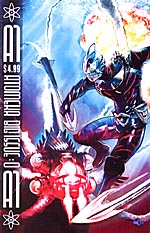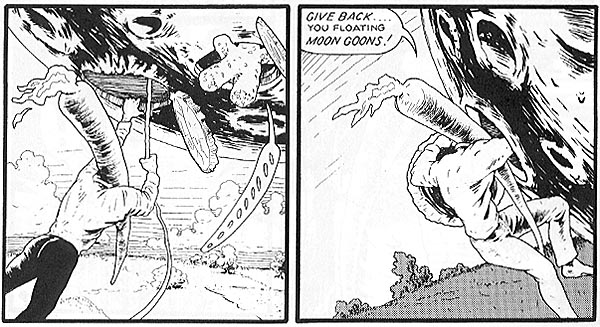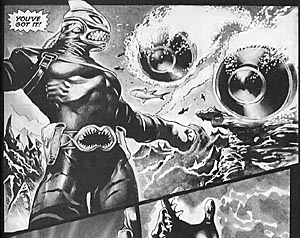 Written by Alan Moore, Steve Dillon, Ronald Shusett, Bob Burden, and Dave Gibbons
Written by Alan Moore, Steve Dillon, Ronald Shusett, Bob Burden, and Dave Gibbons
Art by Steve Parkhouse, Steve Dillon, Steve Pugh, Bob Burden, and Ted McKeever
48 pages, black and white
Published by Atomeka Press
Let there be no doubt about it: the original incarnation of the A1 comic anthology was nothing short of spectacular. With each new issue, the one certainty was that you’d get a lot of top-notch stories by some of the best writers and artists in the business. And then, after six issues and one special edition, that was it. (Well, there was the not-quite-as-good A1 anthology mini-series from Marvel’s Epic imprint but we’re willing to forget it.) Now Atomeka Press has brought A1 back from limbo… but is it the same?
It helps a great deal that three of the five stories in this new incarnation are actually reprints from the earlier days of A1, and that Atomeka Press has wisely chosen some of the high points of the original series. Alan Moore and Steve Parkhouse’s “The BoJeffries Saga” is an all-time classic of comics, with a British family that out-stranges the Addams Family and Muensters by several miles. Moore’s ever the master of introductions, letting us meet this oddball family through the eyes of an outsider as a rentman comes to try and collect back moneys. As the poor hapless rentman (by the pathetic name of Trevor Inchmale) meets each member of the family one at a time, Moore carefully increases the level of insanity, until by the time Grandfather arrives… well, it’s nice to see that even early in his career, Moore was a master of the form.

A different sort of lunacy describes Bob Burden’s “The Bandit Moons!” starring Flaming Carrot. An “unsolved mystery”, Burden’s story is almost a series of non-sequiturs as evil moons swoop down to attack a peaceful picnic lunch that Flaming Carrot and his friends were enjoying. It’s silly from start to finish, with sky hooks scooping up picnic baskets and participants alike even as everyone scatters for cover. At the same time, though, Burden’s able to hook the reader just as easily as the Bandit Moons snag little Sponge Boy in this story; when the story’s over you really want to see more. Burden’s light inks lines help seal the package, with a delicate look to the characters and situations in the book making the entire story attractive to view even as you giggle through its four pages of fun. It’s a sharp contrast to Dave Gibbons’s and Ted McKeever’s “Survivor”, which is often referred to as the best Superman story ever told, despite not actually being officially Superman. I don’t know about best, but it is an amazingly good story. Gibbons’s take on the outsider from another world is bittersweet in its protagonist’s attempts to fit in and never truly managing to do so. In just ten pages Gibbons shows a complete and utter understanding of Superman, even as McKeever cleverly draws everything from Superman’s viewpoint, with his outstretched hands grasping outwards, forever empty, into each panel. Really, for “Survivor” or “The BoJeffries Saga” alone, A1: Big Issue #0 is worth buying.
 The two new stories in A1 are unfortunately not quite as strong. Steve Dillon’s “Kathleen’s House” is by no means a bad story, but it just doesn’t quite stand out among the other, stronger inclusions. It’s a nice little character piece about missing someone who’s gone away, but I have to admit that I was more excited by seeing more of Dillon’s artwork, with his trademark character designs of working class Irishmen. On its own, it’s a stronger story than seen among most of its companions in A1. The same unfortunately can’t be said for Ronald Shusett and Steve Pugh’s work on “Shark-Man”. The good news is that Pugh’s art is gorgeous, with subtle graytones accentuating rounded figurework to create his characters. This is easily Pugh’s best artwork in his career, which makes it a bit of a pity that it’s attached to such a lackluster story. If “Survivor” is a riff on Superman, then “Shark-Man” is almost a wholesale theft of Batman in this first chapter. A rich playboy businessman who dresses up like a humanoid animal to fight crime, complete with cave lair and butler assistant is more than a bit too similar, but Shusett doesn’t stop there when it comes to trotting out the cliches. With mistrusting sons spouting tired chestnuts like, “Come to think of it, I don’t know my dad”, the innocent-acting secretary, and the governor who turns on the protagonist (who up until now has been his friend) at the first sign of danger, this is painful to read from start to finish. It ends on a cliffhanger, but unlike all of the other stories in A1, this is the one where I really don’t want to know what happens next.
The two new stories in A1 are unfortunately not quite as strong. Steve Dillon’s “Kathleen’s House” is by no means a bad story, but it just doesn’t quite stand out among the other, stronger inclusions. It’s a nice little character piece about missing someone who’s gone away, but I have to admit that I was more excited by seeing more of Dillon’s artwork, with his trademark character designs of working class Irishmen. On its own, it’s a stronger story than seen among most of its companions in A1. The same unfortunately can’t be said for Ronald Shusett and Steve Pugh’s work on “Shark-Man”. The good news is that Pugh’s art is gorgeous, with subtle graytones accentuating rounded figurework to create his characters. This is easily Pugh’s best artwork in his career, which makes it a bit of a pity that it’s attached to such a lackluster story. If “Survivor” is a riff on Superman, then “Shark-Man” is almost a wholesale theft of Batman in this first chapter. A rich playboy businessman who dresses up like a humanoid animal to fight crime, complete with cave lair and butler assistant is more than a bit too similar, but Shusett doesn’t stop there when it comes to trotting out the cliches. With mistrusting sons spouting tired chestnuts like, “Come to think of it, I don’t know my dad”, the innocent-acting secretary, and the governor who turns on the protagonist (who up until now has been his friend) at the first sign of danger, this is painful to read from start to finish. It ends on a cliffhanger, but unlike all of the other stories in A1, this is the one where I really don’t want to know what happens next.
Editors Dave Elliott and Garry Leach have certainly shown great judgment in picking gems from A1‘s past for the first issue of the relaunch of the anthology; if they can keep doing that, plus finding stories that are of the same caliber, A1‘s going to quickly re-establish itself as the anthology that you need to read. Hopefully “Shark-Man” was the exception and not the rule, because if all future new material is along those lines, the book may be in trouble. Here’s hoping for the former and not the latter.
